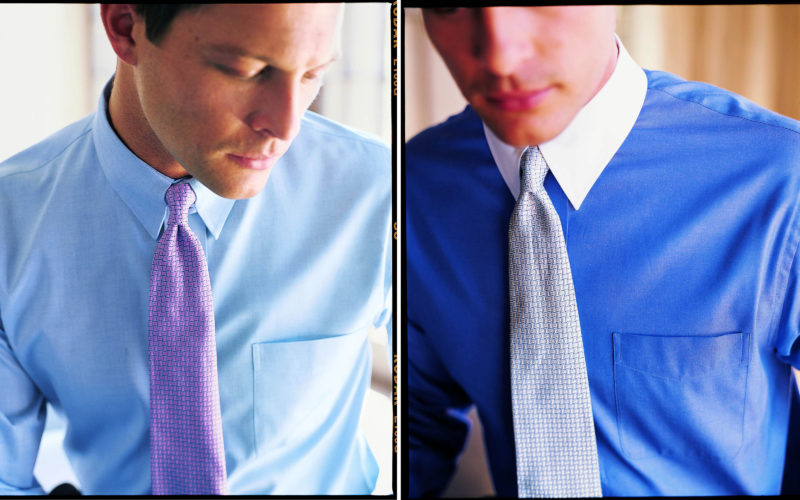Q. I have blue eyes and my wife says I should wear a lot of blue shirts. She says they look good on me, but I don’t want to look like I’m wearing the same shirt all the time and unlike white shirts I think they stand out as repetitive. Other than wearing less professional bright blues what would be a solution?
A. Nothing is more popular today than a blue shirt and it sounds as if they are good as your “go-to” choice and even as your “signature look.” But there is no reason why your shirts should look as if you are wearing the same one over and over again. The range of blue shirts that a man has to choose from is huge without resorting to something like electric blue. Possible options include: the shade of blue, the fabric, pattern, collar style, and type of cuffs. While some of these are obvious and some are subtle, they can all contribute to a clear-cut difference. And, for additional variety, you can vary what you wear with the blue shirts.
SHADE OF BLUE: Colors can range from that most versatile hue, a light and dressy powder blue, to the very limiting and informal navy (or, as you mention, the very casual bright blues), and they can be any degree of darkness in between. Do keep in mind that some light blues are slightly on the greenish-blue side; these are practically impossible to coordinate. Other blues have the slightest hint of purple. If you are good with color, you can pull off a wonderful combination by wearing one of these with just the right red-and-blue tie. From a slight distance, your tie will assume a faint purple cast that blends beautifully with that shade of powder blue shirt.
FABRIC: Fine, smooth cotton broadcloth is the dressiest shirt fabric; pinpoint Oxford cloth is next; standard Oxford cloth follows; and rougher textures such as seersucker, denim, and flannel are the most casual. You may think that others will not notice the difference, but anyone observant enough to worry you about the idea of repeating the shirt, will be observant enough to distinguish these varieties (yes, especially women).
PATTERN: The most popular blue shirts are classic solids from light powder blue to a medium blue known as French blue. But that is far from your full range:
- Many blue shirts are patterns, usually stripes. Blue-and-white striped shirts have a whole hierarchy of formality of their own.
- A hairline stripe, the thinnest of pale blue lines woven into fine cotton broadcloth fabric, is one of the more elegant looks for business and social wear. You won’t find it in every store, but there is usually a good representation of this aristocrat of shirts in better shops.
- A wider (but still narrow) blue-and-white stripe, particularly in Oxford cloth, is a classic; it goes with most suits and blazers.
- The most distinctive and different blue striped shirt is known as a Bengal stripe; it is bold (both in the size of the stripe and in the darkness of the blue stripe on a white background). These vivid, widely-spaced stripes can be challenging. They are harder to coordinate with suits and ties, yet they can be effective when done well.
- Other patterns include subtle end-on-end weaves, herringbones, gingham checks, and colored tiny plaid/squares on a white background known as tattersall. These are all dress and/or business shirts.
- Your concern regarding the nonprofessional shirts should be extended to large plaids, oversized prints, and Hawaiian aloha shirts; these are far more casual, and not meant for business (not even on Zoom).
COLLAR: The most common shirt collars are a straight-point, a spread, and a button-down. The first two are dressy, and the button-down has an Ivy League element with a slightly casual attitude. But there are even further variations within these categories. Wide-spreads have a more dressy feel and require a tie with a larger knot than shirts with a slight spread. Spreads and straight-point collars are ideally worn well-ironed and slightly starched (or with collar stays), while more casual button-downs should have a soft “roll” (no starch).
Depending upon the formality of your office/setting, both button-downs and the straight-point collars can be worn tieless, that is, “open-at-the-neck.” Although you will see men wearing spread collars without a necktie, I feel the look is incongruous, “mixing apples and oranges.”
CUFFS: French cuffs are dressy and require cuff links. The cuff links themselves offer an unlimited number of choices (luxurious precious metals, simple silk knots, colorful or whimsical designs) which can set one man’s look apart quite dramatically from those of his colleagues. There are men who think French cuffs are only for black tie affairs, and others who never wear anything else. On the other hand, barrel cuffs (buttoned at the wrist) are less formal. While both types can be worn with the sleeve cuffs turned up, this casual look is more appropriate for shirts with button cuffs.
Now, I have barely touched upon the varieties of ties, suits, blazers, sweaters, and even trousers and accessories. Generally speaking any of those, when they stand out, will leave questions of repetition forgotten. For that matter, based on your wife’s description, it sounds as though your eyes might also be positively distracting to others!
Please send your men’s dress and grooming questions to MALE CALL: Lois.Fenton@prodigy.net









